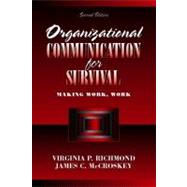
All chapters conclude with “References and Recommended Readings” and “Study Guide.”
Preface.
1. The Nature of Organizations.
Types of Organizations.
Common Characteristics of All Organizations.
Organizational Environments.
Preliminary Principles for Peons.
2. The Nature of Communication in Organizations.
Myths and Misconceptions about Communication in Organizations.
Organizational Communication Defined.
Components of Communication.
Functions of Communication in Organizations.
Organizational Communication Networks.
Formal Communication Flow and Impact.
3. Nonverbal Behavior and Communication.
Significance of Nonverbal Communication in Organizations.
Functions of Nonverbal Messages.
Categories of Nonverbal Messages.
Immediacy and Organizational Communication.
Outcomes of Immediacy Behavior.
Drawbacks of Immediacy.
4. Administration, Supervision, and Communication.
Supervisors' Duties: Subordinates' Views.
Why Aren't Managers Doing Their Jobs?
To Supervise or to Administer? That Is the Question.
What Kind of Manager Do You Have?
5. Barriers to Effective Communication.
Climate Control.
Status.
Communication Overload.
Defensiveness.
6. Communication and Individual Differences.
Organizational Types.
Personality Types.
7. Perceptions of People in Organizations.
Source Credibility.
Interpersonal Attractiveness.
Homophily.
Other Interpersonal Perceptions.
8. Approaches to Management.
Early Orientations.
Leadership Approaches.
Socio-Communicative Orientations and Styles.
The Ideal Leader?
9. Management Communication Styles and Decision-Making.
Management Communication Styles (MCS).
Why Managers Select One MCS over Another.
Identifying the MCS.
10. Power and Status.
Nature of Status.
Status Symbols.
Communication and Status.
Power.
From the Peon's Perspective.
11. Organizational Culture.
Defining Culture.
Culture and Communication.
Cultural Terminology.
Organizations and Cultures.
Ethnocentrism.
12. Communication and Change.
Why People Resist Change in Organizations.
Informal Communication Network Roles.
Innovativeness: The Willingness to Adopt.
13. Introducing Change.
Stages of the Adoption Process.
Characteristics or Attributes of Innovations.
Six Conditions Necessary for Successful Change.
14. Disagreement, Conflict, and Groupthink.
Disagreement and Conflict.
Tolerance for Disagreement.
Conflict Prevention.
Conflict Management.
Groupthink: Too Much Agreement for the Good of the Organization.
15. Effective Supervisory and Subordinate Relationships.
Why Some Do Not Survive: Ten Common Communication Mistakes.
How to Survive: Common Communication Strategies for Survival.
Index.
The New copy of this book will include any supplemental materials advertised. Please check the title of the book to determine if it should include any access cards, study guides, lab manuals, CDs, etc.
The Used, Rental and eBook copies of this book are not guaranteed to include any supplemental materials. Typically, only the book itself is included. This is true even if the title states it includes any access cards, study guides, lab manuals, CDs, etc.